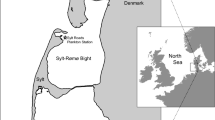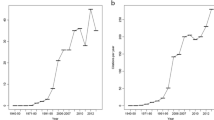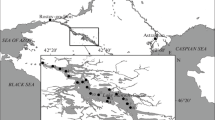Abstract
A checklist based on net samples taken twice weekly from 2001 until May 2003 is presented. Identification is based on observations under direct light microscopy and after taking some organisms in culture. The checklist includes 227 taxa observed at the Helgoland Reede sampling station. One hundred and thirty-two species of diatoms from 53 genera and 95 species of dinoflagellates from 35 genera have been recorded from net samples and cultures. Thirty-five diatom and 28 dinoflagellate taxa were documented in the Helgoland phytoplankton for the first time. The list does not claim to be complete, but provides an updated list of the taxa found at Helgoland and, for convenience, also includes data published for different adjacent areas.
Similar content being viewed by others
Introduction
Phytoplankton species composition and physico-chemical parameters have been recorded in the framework of a time series at Helgoland since 1962 (Hagmeier et al. 2004; Van Beusekom et al. 2004; Wiltshire and Dürselen 2004; Wiltshire et al. 2004). The Helgoland Reede station is sampled daily on weekdays. Water-bottle samples were fixed and phytoplankton taxa counted mainly for the estimation of the carbon content (quantification for the determination of biomass).
Since the species survey by Drebes from 1966 to 1971 (Drebes 1974), there has been no continuous species composition record from net samples. For that reason there was no actual data set covering microphytoplankton species diversity. This knowledge is not only important for getting an idea about the percentage of species diversity coverage that is recorded in the Helgoland timeseries, but also because there are continuous species composition records for the Wadden Sea phytoplankton at Sylt, Germany. The data presented here are the first results of an intensive taxonomic phytoplankton reinvestigation. They could be used as a basis for phytoplankton count quality control and for the start of a continuous detailed species recording in the framework of the Helgoland time series. Since the publication of the 1976 list (Drebes and Elbrächter 1976), nomenclatural changes have been sufficiently numerous to warrant the present list, incorporating additions, synonyms and corrections. Only those species that have been personally observed by the author and/or by Drebes (Drebes 1974; Drebes and Elbrächter 1976) are listed. It is an addition to the checklist of benthic species found in the vicinity of the island of Helgoland (Harms 1993).
Methods
Net samples from the surface water of the Helgoland Reede station (54°11.30′N 7°54.00′E) were collected twice a week from 2001 until May 2003 for qualitative species identification (in addition to the routine water-bottle samples for biomass determination). Nets of different mesh size, 20 µm and 80 µm, were used. The samples were brought to the laboratory and living organisms in small Petri dishes were identified using an inverted light microscope equipped with seawater-immersion objectives for about half a day. All species observed and identified were listed. Additionally, diatom cells were isolated and cultured and some samples were fixed with Lugol’s solution, for further investigations with a scanning electron microscope. For frustule preparation, diatom cultures were boiled in nitric acid and washed 10 times with distilled water.
The species are listed alphabetically within each class. Some synonyms, previously in common use, are given behind the species names for an easier comparison between the findings presented here and older publications and the cited lists.
Results
Table 1 gives a list of the marine phytoplankton diatoms and dinoflagellates found in Helgoland and other North Sea areas
The following changes should also be noted: the genus Neocalyptrella Hernández-Becerril et Meave has replaced Calyptrella (Hernández-Becerril and Meave del Castillo 1997); and Stauropsis membranacea is a synonym of Meuniera membranacea (Cleve) P.C. Silva (Hasle and Syvertsen 1997).
During the year of revision (May 2003 to April 2004), some additional species were recorded at the Helgoland Reede station: Chaetoceros rostratus Lauder; Dactyliosolen fragilissimus (Bergon) Hasle; Fragilaria islandica Grunow sensu Drebes (1974); Stephanopyxis cf palmeriana (Greville) Grunow; and Amphidinium crassum Lohmann.
Discussion
One hundred and thirty-two species of diatoms from 53 genera and 95 species of dinoflagellates from 35 genera were recorded from net samples and cultures. From these 227 taxa, 35 diatoms and 28 dinoflagellate taxa were documented in the Helgoland phytoplankton for the first time. Eleven diatom and four dinoflagellate species could not be found again. Since the publication of the 1976 list (Drebes and Elbrächter 1976), numerous nomenclatural changes have occurred. This list does not claim to be complete, but provides an updated listing. Further continuous observations will be necessary to complete the species list.
Some taxa have been observed but not yet identified to species level, e.g. Thalassiosira spp, Chaetoceros spp, Cyclotella sp, Licmophora spp, Navicula spp, Nitzschia sp, Pleurosigma spp, some benthic diatoms, dinoflagellate species of the Diplopsalis group, Gymnodinium spp, Gyrodinium spp, and Protoperidinium spp. In addition, Pseudo-nitzschia multiseries (Hasle) Hasle was identified in earlier Helgoland samples (Hasle 1995; Hasle et al. 1996) and should be mentioned here because it is toxic.
There have been some single records of benthic, sand-dwelling dinoflagellates: Adenoides eludens (Herdman) Balech, 1956; Amphidinium bipes Herdman, 1924; Amphidinium glabrum Hoppenrath & Okolodkov, 2000; Amphidiniopsis galericulata Hoppenrath, 2000; Prorocentrum clipeus Hoppenrath, 2000; and Thecadinium ornatum Hoppenrath, 2000. In my opinion, these tychoplanktonic species occurred only “by accident” in the plankton and therefore they were not included in the present checklist. Other regularly observed plankton species from other groups include: Phaeocystis globosa Scherffel; Dictyocha speculum Ehrenberg; and Ebria tripartita (Schumann) Lemmermann (see also Drebes 1974).
Detection of long-term trends in the species composition needs more detailed investigations. The high number of “first” records (63) should not be interpreted as a real change in species composition but as a result of more detailed species knowledge. Drebes and Elbrächter have experienced the same results at the Sylt station, Wadden Sea since 1976. Additionally, there have been some newly described species since the 1970s. Some small Thalassiosira species could only be identified using scanning electron microscopy. Since Drebes and Elbrächter’s (1976) checklist, only Coscinodiscus wailesii (Boalch and Harbour 1977; Robinson et al. 1980) and Thalassiosira punctigera (Nehring 1998) have been documented as introduced species. The present list may include some native species which were only discovered recently but may have been around long before without being noticed, because our attention and taxonomic expertise generally decrease with decreasing size of the organisms. Therefore, there is a great need for intensive phytoplankton species documentation as a baseline for a less ambiguous recognition of changes in the species composition with respect to toxic species occurrence and global change aspects. A continuous routine net phytoplankton species monitoring, in combination with the regular determination of the species abundance, is essential.
The comparison of checklists is problematic because of the subjective taxon recognition by the authors and the lack of illustrations of the observed specimens. But it may be useful (e.g. for biogeographic comparisons) to compare this species list with data from other areas, and for convenience records have been added to Table 1 (columns labelled 4–12; Grøntved 1952; Braarud et al. 1953).
References
Boalch GT, Harbour DS (1977) Unusual diatom off the coast of south-west England and its effect on fishing. Nature 269:687–688
Braarud T, Heimdal BR (1970) Brown water on the Norwegian coast in autumn 1966. Nytt Mag Bot 17:91–97
Braarud T, Gaarder KR, Grøntved J (1953) The phytoplankton of the North Sea and adjacent waters in May 1948. Rapp P-V Réun Conseil Int Explor Mer 133:1–87
Drebes G (1974) Marines Phytoplankton. Eine Auswahl der Helgoländer Planktonalgen (Diatomeen, Peridineen). Thieme, Stuttgart.
Drebes G, Elbrächter M (1976) A checklist of planktonic diatoms and dinoflagellates from Helgoland and List (Sylt), German Bight. Bot Mar 19:75–83
Elbrächter M (1999) Exotic flagellates of coastal North Sea waters. Helgol Meeresunters 52:235–242
Elbrächter M, Schnepf E (1996) Gymnodinium chlorophorum, a new, green, bloom-forming dinoflagellate (Gymnodiniales, Dinophyceae) with a vestigial prasinophyte endosymbiont. Phycologia 35:381–393
Grøntved J (1952) Investigations on the phytoplankton in the southern North Sea in May 1947. Medd Komm Dan Fisk Havunders Ser Plankt 5:1–49
Hagmeier E, Spindler H, Van Beusekom J, Wiltshire K (2004) Historical background to the timeseries. Helgol Mar Res (in press)
Hällfors G Baltic Sea phytoplankton species checklist. http://jolly.fimr.fi/Checklist3.nsf
Hansen G, Larsen J (1992) Dinoflagellater i danske farvande. In: Thomsen HA (ed) Plankton i de indre danske farvande. Havforskning fra Miljostyrelsen 11, pp 45–155
Harms J (1993) Check list of species (algae, invertebrates and vertebrates) found in the vicinity of the island of Helgoland (North Sea, German Bight) – a review of recent records. Helgol Meeresunters 47:1–34
Hartley B (1986) A check-list of the freshwater, brackish and marine diatoms of the British Isles and adjoining coastal waters. J Mar Biol Assoc UK 66:531–610
Hasle GR (1995) Pseudo-nitzschia pungens and P. multiseries (Bacillariophyceae): nomenclatural history, morphology, and distribution. J Phycol 31:428–435
Hasle GR, Syvertsen EE (1997) Marine diatoms. In: Tomas CR (ed) Identifying marine phytoplankton. Academic Press, pp 5–385
Hasle GR, Lange CB, Syvertsen EE (1996) A review of Pseudo-nitzschia, with special reference to the Skagerrak, North Atlantic, and adjacent waters. Helgol Meeresunters 50:131–175
Heimdal BR, Hasle GR, Throndsen J (1973) An annotated check-list of plankton algae from the Oslofjord, Norway (1951–1972). Norw J Bot 20:13–19
Hendey NI (1974) A revised check-list of British marine diatoms. J Mar Biol Assoc UK 54:277–300
Hernández-Becerril DU, Meave del Castillo ME (1997) Neocalyprella gen. nov., a new name to replace Calyprella Hernández-Becerril et Meave. Phycologia 36:329
Hickel W, Hagmeier E, Drebes G (1971) Gymnodinium blooms in the Helgoland Bight (North Sea) during August, 1968. Helgol Wiss Meeresunters 22:401–416
Jensen KJ, Moestrup Ø (1998) The genus Chaetoceros (Bacillariophyceae) in inner Danish coastal waters. Opera Bot 133:1–68
Kuylenstierna M, Karlson B (2000) Checklist of phytoplankton in Skagerrak-Kattegat. http://www.marbot.gu.se/SSS/SSShome.htm
Leewis RJ (1985) Phytoplankton off the Dutch coast. A base line study on the temporal and spatial distribution of species in 1974 and 1975. PhD Thesis, Van Gorcum, Assen
Nehring S (1998) Non-indigenous phytoplankton species in the North Sea: supposed region of origin and possible transport vector. Arch Fish Mar Res 46:181–194
Ostenfeld CH (1908) On the immigration of Biddulphia sinensis Grev. and its occurrence in the North Sea during 1903–1907. Medd Komm Havunders Ser Plankt 1:1–44
Pankow H (1990) Ostsee-Algenflora. Fischer, Jena
Parke M, Dixon PS (1976) Check-list of British marine algae – 3rd revision. J Mar Biol Assoc UK 56:527–594
Reise K, Gollasch S, Wolff WJ (1999) Introduced marine species of the North Sea coasts. Helgol Meeresunters 52:219–234
Robinson GA, Budd TD, John AWG, Reid PC (1980) Coscinodiscus nobilis (Grunow) in continuous plankton records, 1977–78. J Mar Biol Assoc UK 60:675–680
Sournia A, Belin C, Billard C, Catherine M, Erard-Le Denn E, Fresnel J, Lassus P, Pastoureaud A, Soulard R (1992) The repetitive and expanding occurrence of a green, bloom-forming dinoflagellate (Dinophyceae) on the coasts of France. Cryptogam Algol 13:1–13
Van Beusekom J, Mangelsdorf P, Wiltshire K (2004) The nutrient data of the Helgoland Reede: quality assessment and usefulness. Helgol Mar Res (in press)
Wiltshire K, Dürselen C (2004) The Phytoplankton data of the Helgoland Reede: quality assessment and usefulness. Helgol Mar Res (in press)
Wiltshire K, Dürselen C, Spindler H (2004) Description of the Helgoland data sets and archiving. Helgol Mar Res (in press)
Acknowledgements
I would like to thank H. Halliger, Wadden Sea station Sylt, AWI, for the introduction to phytoplankton diatom identification; M. Elbrächter, Taxonomische Arbeitsgruppe am Forschungsintitut Senckenberg, for his taxonomic advice and his help in the identification of some dinoflagellates; and R. Crawford, AWI Bremerhaven, for valuable comments and his kindness in correcting the English. L. Medlin, AWI Bremerhaven, kindly helped identify the Pseudo-nitzschia species and J.E.B. Rines, University of Rhode Island, identified Chaetoceros rostratus.
Author information
Authors and Affiliations
Corresponding author
Additional information
Communicated by K. Wiltshire
Rights and permissions
About this article
Cite this article
Hoppenrath, M. A revised checklist of planktonic diatoms and dinoflagellates from Helgoland (North Sea, German Bight). Helgol Mar Res 58, 243–251 (2004). https://doi.org/10.1007/s10152-004-0190-6
Received:
Revised:
Accepted:
Published:
Issue Date:
DOI: https://doi.org/10.1007/s10152-004-0190-6




